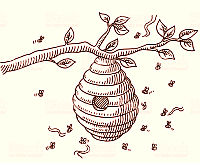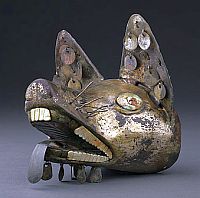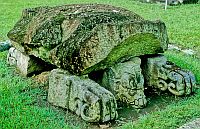
|
|
Mesoamerica and South AmericaStar Lore of the
|
|


|
|
Aquarius |

|
|
Maya
Maya constellations are widely disputed, but
Susan Milbrath: Star Gods of the Ancient Maya
sees evidence that the Maya may have seen a bat in the constellation Aquarius.
|
 Maya Bat Statue
Maya Bat StatueSource: Maya Archaeology |



|
|
Aquila |

|
Maya
The Quiche saw Aquila as a hawk. They linked the southward migration of the
Swanison's hawk with the movement of Aquila.
|
 Swainson's hawk
Swainson's hawkSource: Wikipedia |



|
|
Aries |

|
|
Maya
Maya constellations are widely disputed, but
Susan Milbrath: Star Gods of the Ancient Maya
sees evidence that the Maya may have seen an Ocelot in the constellation Aries.
|

|
|
Inca
In indigenous Peruvian astronomy, a constellation with most of the same stars as Aries was called the "Market Moon" and the "Kneeling Terrace", as a
reminder for when to hold the annual harvest festival, Ayri Huay.
|

|



|
|
Crux, Centaurus,
and the Coalsack Nebula
The further south one travels, the brighter the Southern Cross shines.
|
 Alpha and Beta Centauri pointing towards the Cross
Alpha and Beta Centauri pointing towards the CrossSource: earthsky.org  Right: Coalsack Nebula and Southern Cross Source: Wikipedia |

|

|
|
Alpha Centauri and Hadar (β Centauri) are among the brightest stars in the southern sky - Alpha Centauri is the third brightest star in the night sky. The two stars are called the Pointers, as a line connecting the two leads directly to the southern Cross. |

|
|
The Coalsack Nebula is the most prominent dark nebula in the skies, visible to the naked eye near the Southern Cross, as a dark patch obscuring a brief section of the Milky Way. |


|
|
Bororo
The Bororo people in what is now the Brazilian state of Mato Grosso had a constellation called
the Great Rhea, encompassing the stars of Centaurus and
Circinus and the bright stars Alpha and
Beta Centauri, which made up one foot of the big bird.
|


|
|
Mocoví
Alejandro López
relates the cosmology of the Mocoví people of the Gran Chaco area to the the Coalsack Nebula and
a mythical being called the Mañic.
|

|
A Mocoví mythical tale has that a powerful man decided to face the Mañic.
He chased the Mañic throughout the world and the cornered Mañic climbed up the ombú trunk (the tree of the world) to the sky.
 Today, the shadow-soul (la 'al) of the Mañic can be seen in the Milky Way's dark clouds, with its head in what we know as the Coalsack. Alpha and Beta Centauri are dogs chasing the Mañic and bite at its neck."  Source: Steven R. Gullberg et al. A Comparison of Dark Constellations of the Milky Way |
 The Mañic; art by Jessica Gullberg,
The Mañic; art by Jessica Gullberg,constellation from López and Alterlieb Source: researchgate.net |


|
|
Bakairi
The Bakairi people in what is now the Brazilian state of Mato Grosso had a sprawling
constellation representing a bird snare. It included the bright stars of Crux and the southern part of Centaurus, together with stars from
Circinus,
Lupus,
Musca,
Chamaeleon,
Volans and
Mensa.
|

|

 |

The Kalapalo people, also of Mato Grosso
saw the Coalsack Nebula as a beehive-had and the stars
of the Southern Cross as Aganagi, angry bees that had emerged from the hive.
|
 Bee Hive
Bee HiveSource: clipart.email |

|
|
Mapuche
In the language of the Mapuche, the Southern Cross is called Melipal, meaning "four stars.
|


|
|
Inca
In Quechua, the language of the Inca civilization, Crux is known as Chakana.
 Literally, Chakana means "stair" (chaka = bridge, link; hanan = high, above).  Source: Wikipedia |
 Stairs on the Inca Trail
Stairs on the Inca TrailSource: denomades.com |



|
|
Gemini |

|
|
Aztecs
McIvor sees evidence
of a frog seen in the constellation Gemini with the stars
Castor (α Gem) and
Pollux (β Gem) being the frog's google eyes.
|
 Frog Statue at the National Museum of Anthropology, Mexico City
Frog Statue at the National Museum of Anthropology, Mexico CitySource: Mexicolore |

| McIvor's observation is based on the research of friar Diego Durán, who in the late 1500s wrote one of the first books on the history and culture of the Aztecs. McIvor's stresses, that his observations are just attempts of an interpretation, but given the authority of Durán, we decided to include them in our study. |



|
|
Milky Way Dark Constellations of the Inca |

The dark constellations of the Incas stretch across nearly 150° of the Milky Way’s expanse. Most are animals that figure prominently in Andean
cosmology and myth.
 Gary Urton relates that the Spanish chronicler Polo de Ondegardo found the Incas to believe that “the animal constellations were responsible for the procreation and augmentation of their animal counterparts on the earth.  |
 Dark Constellations of the Inca;
Source: Somnium Project
Dark Constellations of the Inca;
Source: Somnium Project
|
|
Sources: Gary Urton: At the Crossroads of the Earth and the Sky: An Andean Cosmology Steven R. Gullberg et al. A Comparison of Dark Constellations of the Milky Way Gullberg, Steven Roland: The cosmology of Inca huacas. The following descriptions of Inca Dark Constellations are quoted from A Comparison of Dark Constellations...
|

Mach'acuay - the Snake
 Serpents figure prominently in Inca cosmology and are the creatures representing Uchu Pacha, the underworld and lowest of the three worlds of Inca existence. Machacuay leads this dark celestial procession as the constellations move left to right across the night sky.  Van de Guchte says that the amaru, or serpents, emerged from their underworld environs via rivers and are thought to be related to rainbows and to foretell of rain.Machacuay can be seen at the beginning of the rainy season.  The serpent’s dark figure is long like a snake and travels head before the tail. |

|

Hanp’atu - the Toad
 Hanp’atu follows closely behind Machacuay. Toads were thought of as bad omens as they were created by the devil.  Hanp’atu is a much smaller dark section of the Milky Way to the left of the snake. |
 Incan Toad Mortar 15th century
Incan Toad Mortar 15th centurySource: liveauctioneers.com |

Yutu - the Tinamou
 Tinamou are birds indigenous to the Andes and are of very ancient lineage. Yutu, the Tinamou, follows Hanpatu in the Milky Way and likewise is much smaller than Machacuay.  This Yutu is adjacent to what we refer to as the Southern Cross, is at zenith on the December solstice, and nadir on the June solstice. We know Yutu as the Coalsack in Western astronomy. |
 Tinamou;
British Museum
Tinamou;
British Museum
|

Another Inca myth mentions the god Ataguchu. Ataguchu and his
twin brother Piguero are part of the Inca creation myths in which they showed the first people how to escape the underworld.
 In a myth told on the website of the European Southern Observatory, Ataguchu kicked the Milky Way in a fit of anger, causing a fragment to fly off and form the Small Magellanic Cloud. The Coalsack is the black mark left behind where the broken fragment was.  Sources: European Southern Observatory, constellation-guide.com |

Yacana - the Llama
 Llamas figure prominently in many aspects of Inca culture and this celestial figure was thought to animate the llamas on the Earth. Yacana is a constellation much larger than Hanpatu or Yutu and dominates the Incas’ dark constellation section of the Milky Way.  Yacana is situated between Centaurus and Scorpio. The prominent stars Alpha and Beta Centauri serve as the llama’s eyes and as such are known as Llamacñawin, the "eyes of the llama."
Uñallamacha - the Baby Llama
|

|


Atoq - the Fox
 Following Yacana and Uñallamacha in the sky from the left is the somewhat smaller constellation of Atoq, the fox. Atoq lies on the ecliptic between the constellations of Scorpio and Sagittarius and the Sun enters it during the December solstice.  Urton relates that the Milky Way and Atoq catch up and rise with the summer solstice Sun in the southeast during the same period of time that terrestrial baby foxes typically are born. "... the sun rises into [Atoq] ... from about December 15 to December 23." |
 Moche Fox Headdress, 1st cent. AD
Moche Fox Headdress, 1st cent. ADSource: Museo Oro del Perú |

Urton lists a second constellation called Yutu. This additional tinamou follows Atoq and completes the celestial procession.
 Source: Steven R. Gullberg et al. A Comparison of Dark Constellations of the Milky Way Urton also mentions and Inca interpretation of the shiny part of the Milky Way as a heavenly reflection of the sacred Vilcanota River: |

Andean cosmology ties the Milky Way with the Vilcanota River. The Vilcanota flows southeast to northwest through the Sacred Valley, past Machu
Picchu and beyond. Its waters are thought to rise into the Milky Way and, once having traveled its celestial course, fall again to the earth as rain.
 The sun is stronger in the summer because it drinks from the swollen Vilcanota as it travels beneath it at night. It is weaker in the winter because it has had less to drink.  Source: Gary Urton: At the Crossroads of the Earth and the Sky: An Andean Cosmology |
 An illustration of how astronomical phenomena and the sacred mountain & ceremonial center of Machu Picchu could be associated in Inca beliefs
(graphic adapted from Johan Reinhard 2002 / Gary Urton 1981 / Google Earth 2012)
An illustration of how astronomical phenomena and the sacred mountain & ceremonial center of Machu Picchu could be associated in Inca beliefs
(graphic adapted from Johan Reinhard 2002 / Gary Urton 1981 / Google Earth 2012)Source: Peruvian Times |



|
|
Moon
In 3114 BC, Mayan astronomers discover an 18.7-year cycle in the rising and setting of the Moon. From this they created the first almanacs – tables
of the movements of the Sun, Moon, and planets for the use in astrology.
|
 Mayan Calendar
Mayan CalendarMs. Roa's Global History Class |



|
|
Orion
The Aztecs called the stars of Orion’s Belt and
Orion’s Sword the Fire Drill.
|
 Xiuhtecuhtli,
Xiuhtecuhtli,God of Fire Source: Mexicolore |


|
|
Maya
Susan Milbrath
sees evidence that the Maya may have seen a turtle in the constellation Orion.
|
 Cosmic Turtle Altar in Copan Ruinas
Cosmic Turtle Altar in Copan Ruinas© Peter W. Wendelken |


|
|
Bororo
The Bororo people in what is now the Brazilian state of Mato Grosso had a massive constellation
representing a caiman, showcasing the prominence of caimans in daily Amazonian life.
|
 Caiman of the Bororo
Caiman of the BororoSource: fairbanksmuseum.org |



|
|
Ophiuchus and Scorpius |

|
|
Aztecs
McIvor sees evidence
of a rattlesnake as an Aztec constellation created out of stars from Ophiuchus and
Scorpius.
|
 Aztec Snake
Aztec SnakeSource: National Museum of Anthropology, Mexico City |



|
|
Pisces |

|
|
Maya
Maya constellations are widely disputed, but
Susan Milbrath: Star Gods of the Ancient Maya
sees evidence that the Maya may have seen a skeleton in the constellation Pisces.
|



|
|
Pleiades |

|
|
Aztecs
In the Aztecs calendar, the new year began with the heliacal rising of the Pleiades in the east,
immediately before the sun's dawn light obliterated the view of the stars.
|
 Aztec merchants
Aztec merchantsSource: Wikipedia |


|
|
Maya / Olmec
Susan Milbrath
sees evidence that the Maya may have seen the rattle of a rattlesnake in the Pleiades.
The star cluster of the Pleiades is part of the constellation Taurus, but given the amount of Star Lore related to them, they deserve a separate entry. |
 Snake at at La Venta Olmec Museum, Villahermosa
Snake at at La Venta Olmec Museum, Villahermosa© hammocksandruins.com |



|
|
Sun |

|
|
Rego Grande River
In the 1990s, a megalithic stone circle was discovered in the Rego Grande River area in northern Brazil. Excavation began in
2005 and the stones were dated to be between 500 and 2000 years old.
|

|



|
|
Taurus |

|
|
Maya
to the Maya people in Central America,
Theta Tauri was known as Chamukuy.
|


|
Back to Star Lore |
Back to Mythology |
Back to Space Page |
Back to English |
 Back to Start Page |